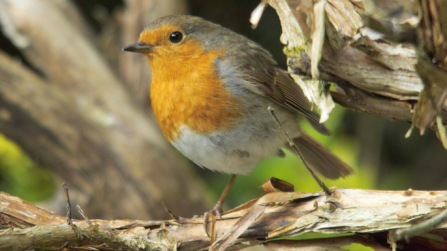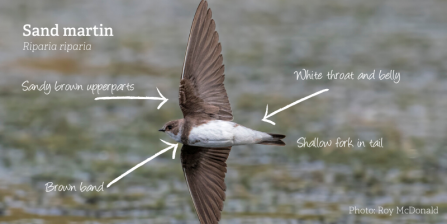
A British woodcock (Scolopax rusticola). Picture: Mark Hamblin/2020Vision
European badger (Meles meles) family and cubs feed in long grass near their woodland sett. Picture: Bertie Gregory/2020VISION

A British woodcock (Scolopax rusticola). Picture: Mark Hamblin/2020Vision
With its mottled and dusky plumage, the wily woodcock is perfectly camouflaged in the woods and heathlands where it lives, but don't be fooled - this bird can do spectacular things.
If you happen to disturb one, it will fly off in a zig-zag pattern between the trees before dropping back down into the dense undergrowth - becoming almost invisible again.
But more impressive than that, at this time of year male woodcocks start to perform their famous display flight to attract a female - known as roding. At dusk and just before dawn, they take to the air and patrol over large areas of their forest and heathland homes, calling in a series of grunts and squeaks, competing with other males to impress potential partners.
One great place to look out for them is our Snelsmore Common reserve near Newbury.

Yew tree flowers. Picture: Erik Agar/ Getty Images
Yew trees are famous across the British Isles as the traditional tree of churchyards: more than 500 churches in England and Wales alone have yews in their grounds that are at least as old as the church itself.
One of the oldest yews in the UK is the Fortingall Yew in Scotland, estimated at somewhere between 2,000 and 9,000 years old.
In winter, these aged sentinels' bright red berries provide festive decoration and a valuable food source for a host of birds and mammals - but have you ever seen their flowers? Yew is actually dioecious, which means male and female flowers grow on different trees - and it relies on the wind to blow pollen from male trees to females. Keep a look out next time you are passing a churchyard and see if you can spot some.

Queen bumblebee feeding on tree peony in garden by Nick Upton/2020VISION
This is the time of year when queen bumblebees, who have spent the entire winter hiding safely underground, emerge from their holes.
Among the first species to emerge are the aptly-named early bumblebee (Bombus pratorum) and the common carder (Bombus pascuorum).
The first thing the queens will do on emerging is go and find some spring flowers such as snowdrops, crocuses or daffodils, to drink as much nectar as they can. They will need the energy: the next thing they have to do is go and find a suitable nest site - often a disused mammal burrow - and start building their nest and laying the first of many eggs.

Famous as friendly visitors to our gardens, robins are actually extremely territorial and will defend their nesting sites aggressively. This is the time of year when they start to build those nests and lay their eggs.
Over the coming weeks, the male will allow a female into his territory, where she will then set up a nest of dead leaves, moss and hair. Nests often crop up in the oddest of places, such as plant pots, old wellies and shelves, but ivy and other shrubs are their natural choice.
Many other garden birds also start nesting at this time of year, such as wrens, thrushes, blackbirds and tits.

A lesser celandine flower growing on a roadside verge in West Berkshire. Picture: Simon Claybourn
A humble-sounding flower, lesser celandine looks its best when large clusters in deciduous woodlands create great carpets of gold between March and May - providing a valuable source of nectar for many insects.
This is also one of the species we are focusing on as part of our West Berkshire Wild Verges project, which is aiming to turn roadside verges across the district into wildlife superhighways. This is because lesser celandine can thrive on grassy verges and help provide the foundations for a healthy ecosystem.

The tiny brown-and-white sand martin is the first of the swallow-like birds to return to the UK after spending the winter in Africa.
From March onwards, you can spot these minute birds swooping over lakes and reservoirs feeding up on insects such as gnats and other flies. Two great places to look out for them are our Hosehill Lake reserve just outside Reading and College Lake near Aylesbury.
Soon, the sand martins will start to make their nests, digging burrows in steep, sandy cliffs, usually around water. These tunnels can be up to a metre long, and in a chamber at the end four or five eggs are laid on collected straw and feathers.
A moorhen. Picture: Gillian Day
One bird that is a permanent resident in our area is the moorhen, and March is the month when many moorhens start to mate.

Moorhen nest. Picture: Amy Lewis
Being a relatively common species, the moorhen offers a great opportunity to watch breeding bird behaviour: the ritual usually begins when the male swims towards the female with its bill in the water, then the two birds eventually nibble at each other's feathers.
Once they have mated, mother and father will then build their nest together out of twigs in emergent vegetation - and defend it with ferocity.
Look out for these big, messy nests in reedbeds and even in tree branches like this in any big river, lake or pond.

European badger (Meles meles) family and cubs feed in long grass near their woodland sett. Picture: Bertie Gregory/2020VISION
Badgers live in large family groups in burrows under the ground called a ‘sett’. Active holes are easy to spot in March as badgers do a spring clean and throw out the old winter bedding. There will also be a particularly smelly pit nearby that the badgers use as a toilet!
Badger cubs are born in January or February, but spend the first few months underground. They will start to emerge around now as the weather warms up - however, being a nocturnal species you won't normally be lucky enough to see them in the daytime.
Sadly, badgers face numerous threats including housing development on their habitat and the ongoing badger cull. Find out about BBOWT's badger vaccination project which is protecting badgers and cattle from Bovine TB: Badger Vaccination Project.

Peacock butterfly on bluebells by Janet Packham Photography
The first butterflies to be seen are usually the ones that have spent the winter as adults: peacocks like this one, small tortoiseshells and bright yellow brimstones.
Like queen bees, the first thing these insects will want to do is find some flowers and get a long drink of nectar to give them energy.
One of the best ways to help butterflies and attract them into your garden is to plant nectar-rich flowers - check out our guide on what to plant.

Cuckoo pint by Kate Morel and BjornS
This strange-looking plant is fairly common in woodlands and along hedgerows, look for curls of green leaves pushing up through the earth at this time of year.
It has a variety of common names, including 'lords and ladies' and jack-in-the-pulpit. The flower is pollinated by flies and later in the year produces bright red berries, which are toxic to humans.
Did you know they have starchy tubers that were used in the production of stiff ruffs in days gone by?
Sign up below to receive the latest news from BBOWT, tips about how you can help wildlife, plus information on how you can get involved.